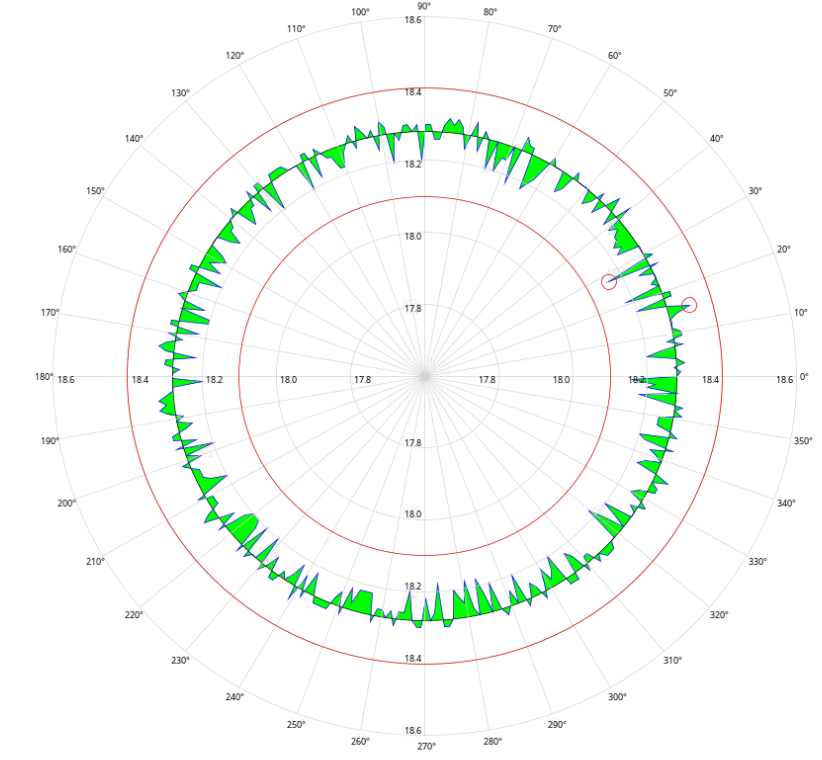Sorry for the late reply, Anton, our family got Covid-tized, so we’re quarantined for a while. The bright side is that I get to help out with this sort of stuff. 
I don’t have a 7.9 system to play with at the moment. You’ll need to make an 8.1 installation if you want to use the file I posted. Note that I trimmed it down to just one pen.
This uses clip methods. Basically, a clip acts as a window so that only things inside the clip shape will render. Different clips were needed for above and below the nominal. After the clip renderings are done, we can then then set the clip to the entire graphic, so we can finish it off as before.
Cgraph_with_highlight_2021-04-03_1727.zip (17.8 KB)

from java.awt import Color
from java.awt import GradientPaint
from java.awt.geom import GeneralPath
from java.awt.geom import Rectangle2D
from java.awt.geom import Ellipse2D
def scp(x, rawLo, rawHi, scaledLo, scaledHi, precision=0):
m=(float(scaledHi)-float(scaledLo))/(float(rawHi)-float(rawLo))
b=scaledLo-(rawLo*m)
if precision<1:
y=int(round(m*x+b,precision))
else:
y=round(m*x+b,precision)
return y
def rect360(rho,theta):
import math
theta=float((theta-360)*math.pi/180)
x=float(0)
y=float(0)
y=rho*math.sin(theta)
x=rho*math.cos(theta)
return x,y
dataIn=system.dataset.toPyDataSet(event.source.Data)
dataLength = len(dataIn)
if len(dataIn)>0:
g = event.graphics
print type(g)
axes=GeneralPath() # path for axes and major gridlines
grid=GeneralPath() # path for minor gridlines
pen = GeneralPath() # path for data
penColor=event.source.Pen1Color
x=0 # Current x-ordinate for each pen
y=0 # Current y-ordinate for each pen
x1=0 # Storage for first x-ordinate for each pen
y1=0 # Storage for first x-ordinate for each pen
FirstPointFlag=0
lowerInBound=float(event.source.LoGraphLimit)
upperInBound=float(event.source.HiGraphLimit)
precision=int(event.source.Precision)
gapTime=event.source.GapTime
if gapTime==0:
gapTime=100000
lowerRhoBound=0.0
upperRhoBound=500.0 #Set size of graph
center=500
UpperXY=center*2
UpperXYBound=UpperXY*1.05
gOffset=(UpperXYBound-UpperXY)/2
hourOffset=event.source.parent.parent.getComponent('Popup Calendar').HourOffset
ccw=event.source.CCW
startTime=event.source.parent.parent.getComponent('Popup Calendar').StartTime.getTime()
penEnabledWord=event.source.PenEnableStatus
penEnabled=[bool(penEnabledWord & 1),bool(penEnabledWord & 2),bool(penEnabledWord & 4),bool(penEnabledWord & 8)]
index = 0.0
minValue = None
maxValue = None
minValueX = 0.0
minValueY = 0.0
maxValueX = 0.0
maxValueY = 0.0
#create data path
for row in dataIn:
if ccw:
theta = 360-index
else:
theta = index
rho=scp(row[1],lowerInBound,upperInBound,lowerRhoBound,upperRhoBound)
x,y=rect360(rho,theta)
if minValue is None or row[1] < minValue:
minValue = row[1]
minValueX, minValueY = x, y
if maxValue is None or row[1] > maxValue:
maxValue = row[1]
maxValueX, maxValueY = x, y
if FirstPointFlag==0:
pen.moveTo(center+x+gOffset,center+y+gOffset)
# Store first point values to complete the graph
x1 = x
y1 = y
else:
diff=(index-lastTimeIn)/1000
if diff > gapTime:
pen.moveTo(center+x+gOffset,center+y+gOffset)
else:
pen.lineTo(center+x+gOffset,center+y+gOffset)
if FirstPointFlag==0:
FirstPointFlag=1
lastTimeIn=index
index += 360.0/dataLength
# Close the loop
pen.lineTo(center + x1 + gOffset, center + y1+ gOffset)
# create gridlines path
for i in range(0,360,10):
coord=rect360(500,i)
axes.moveTo(center+gOffset,center+gOffset)
axes.lineTo(center+gOffset+coord[0], center+gOffset+coord[1])
coord=rect360(500,i)
# set graph scaling to size of the canvas
dX = float(event.width-1)/UpperXYBound
dY = float(event.height-1)/UpperXYBound
g.scale(dX,dY)
#draw everything-- ;)
# draw background
g.setColor(event.source.BackgroundColor)
background=Rectangle2D.Float(0,0,UpperXYBound,UpperXYBound)
g.fill(background)
# This section draws the highlighted areas
#draw filled cirlce at Ideal Diameter, then use it to clip the next graphics
# This lets us highlight the areas below nominal.
radius = event.source.Diameter
n=scp(radius,lowerInBound,upperInBound,lowerRhoBound,upperRhoBound*2)
g.setColor(Color.GREEN)
g.fill(Ellipse2D.Float(center-n/2+gOffset, center-n/2+gOffset, n, n))
g.clip(Ellipse2D.Float(center-n/2+gOffset, center-n/2+gOffset, n, n))
g.setColor(event.source.BackgroundColor)
g.fill(pen)
# set clip back to full graphic
g.setClip(background)
#Set the pen graphic as the clip area.
g.clip(pen)
# draw highlight cicles between max and nominal
radius = maxValue
n=scp(radius,lowerInBound,upperInBound,lowerRhoBound,upperRhoBound*2)
g.setColor(Color.GREEN)
g.fill(Ellipse2D.Float(center-n/2+gOffset, center-n/2+gOffset, n, n))
radius = event.source.Diameter
n=scp(radius,lowerInBound,upperInBound,lowerRhoBound,upperRhoBound*2)
g.setColor(event.source.BackgroundColor)
g.fill(Ellipse2D.Float(center-n/2+gOffset, center-n/2+gOffset, n, n))
# Reset the clip to the maximum area, and draw everything else.
g.setClip(background)
#draw pen
g.setColor(penColor)
g.draw(pen)
# Draw nominal Cirlce
radius = event.source.Diameter
n=scp(radius,lowerInBound,upperInBound,lowerRhoBound,upperRhoBound*2)
g.setColor(event.source.DiameterColor)
g.draw(Ellipse2D.Float(center-n/2+gOffset, center-n/2+gOffset, n, n))
g.setColor(event.source.AxixColor)
g.draw(axes)
# gridline circles
for size in range(0,1001,200):
if str(size)[-2:]=="00":
g.setColor(event.source.MajorGridlineColor)
else:
g.setColor(event.source.MinorGridlineColor)
g.draw(Ellipse2D.Float(center-size/2+gOffset, center-size/2+gOffset, size, size))
#draw circle Tolerance Minus
radius = event.source.ToleranceMinus
n=scp(radius,lowerInBound,upperInBound,lowerRhoBound,upperRhoBound*2)
g.setColor(event.source.ToleranceColor)
g.draw(Ellipse2D.Float(center-n/2+gOffset, center-n/2+gOffset, n, n))
#draw circle Tolerance Plus
radius = event.source.TolerancePlus
n=scp(radius,lowerInBound,upperInBound,lowerRhoBound,upperRhoBound*2)
g.setColor(event.source.ToleranceColor)
g.draw(Ellipse2D.Float(center-n/2+gOffset, center-n/2+gOffset, n, n))
#draw min and max values circle
diameter = 20
g.setColor(event.source.ToleranceColor)
g.draw(Ellipse2D.Float(center+(minValueX-(diameter/2))+gOffset, center+(minValueY-(diameter/2))+gOffset, diameter, diameter))
g.draw(Ellipse2D.Float(center+(maxValueX-(diameter/2))+gOffset, center+(maxValueY-(diameter/2))+gOffset, diameter, diameter))
# values around outer cirlce
g.setColor(Color.BLACK)
for i in range (0,36):
x=(i*10)+hourOffset
if x>360:
x-=360
if ccw:
theta=360-10*i
else:
theta=10*i
coord=rect360(515,theta)
g.drawString(str(x)+u'°',center+coord[0]+gOffset-10,center+coord[1]+gOffset+5)
# Axis values
g.setColor(event.source.ValueTextColor)
for i in range(5):
n=str(scp((i+1),0,5,lowerInBound,upperInBound,precision))
s=n+"0"*(precision-(len(n)-n.find(".")-1))
#print "n= ", n , "s= ", s
x=center+100*(i+1)+gOffset-(3+6*len(s))
y=center+gOffset+10
g.drawString(s,x,y)
x=center+gOffset-(3+6*len(s))
y=center+100*(i+1)+gOffset-3
g.drawString(s,x,y)
x=center-100*(i+1)+gOffset+5
y=center+gOffset+10
g.drawString(s,x,y)
x=center+gOffset-(3+6*len(s))
y=center-100*(i+1)+gOffset+10
g.drawString(s,x,y)















